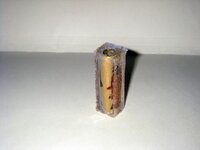montmill
Member
I have a maple blank with a decal on it. The blank was finished with CA and left to dry several days. The decal printed, sprayed with fixative and allowed to dry several days. The decal was applied to the blank and allowed to dry several days when it was finished with a CA finish. It cured for at least two weeks.
Today I cast it in alumilite water clear and after an hour in the pressure pot at 60 psi I took it out. There was some extra alumilite in a cup that had completely set up but the blank in the pot was still soft. I put it in a toaster over on warm for 20 minutes and bubbles appeared all along the decal and in the alumilite. When I removed it from the mold the bottom was still soft and mushy.
Did I read that alumilite and CA don't mix, that I should have used Silmar 41?
Thanks for any help.
Montmill
Today I cast it in alumilite water clear and after an hour in the pressure pot at 60 psi I took it out. There was some extra alumilite in a cup that had completely set up but the blank in the pot was still soft. I put it in a toaster over on warm for 20 minutes and bubbles appeared all along the decal and in the alumilite. When I removed it from the mold the bottom was still soft and mushy.
Did I read that alumilite and CA don't mix, that I should have used Silmar 41?
Thanks for any help.
Montmill

